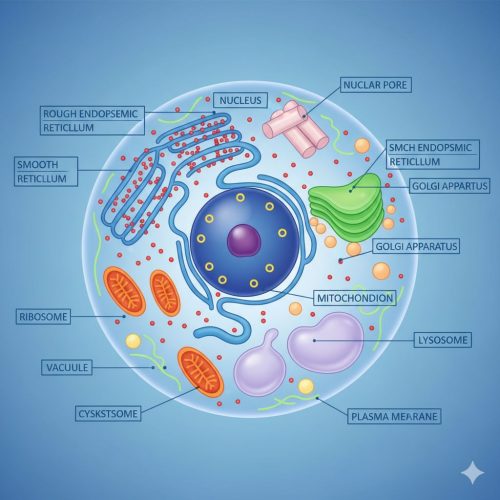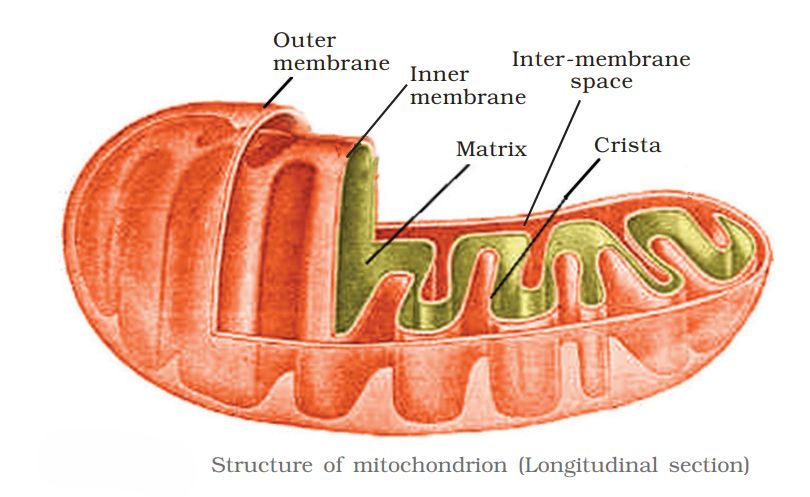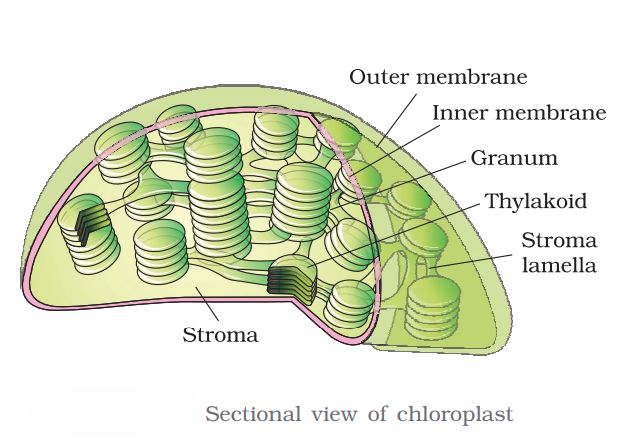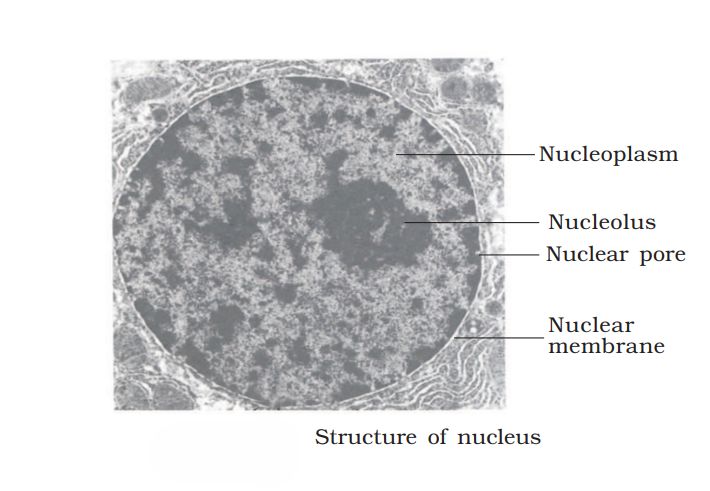1st PUC Biology Question and Answer: Cell: The Unit of Life
Looking for 1st PUC Biology textbook answers? You can download Chapter 8: Cell: The Unit of Life Questions and Answers PDF, Notes, and Summary here. 1st PUC Biology solutions follow the Karnataka State Board Syllabus, making it easier for students to revise and score higher in exams.
Karnataka 1st PUC Biology Textbook Answers—Reflections Chapter 8
Cell: The Unit of Life Questions and Answers, Notes, and Summary
1st PUC Biology Chapter 8
CELL: THE UNIT OF LIFE

Scroll Down to Download Cell: The Unit of Life PDF
Question and Answer:
Question 1.
Which of the following is not correct?
- Robert Brown discovered the cell.
- Schleiden and Schwann formulated the cell theory.
- Virchow explained that cells are formed from pre-existing cells.
- A unicellular organism carries out its life activities within a single cell.
Answer :
(a) Robert Brown discovered the cell. ✅
Question 2.
New cells generate from
- bacterial fermentation
- regeneration of old cells
- pre-existing cells
- abiotic materials
Answer :
(c) pre-existing cells ✅
Question 3.
Match the following
Column I Column II
(a) Cristae (i) Flat membranous sacs in stroma
(b) Cisternae (ii) Infoldings in mitochondria
(c) Thylakoids (iii) Disc-shaped sacs in Golgi apparatus
Answer:
- Cristae → (ii) Infoldings in mitochondria
- Cisternae → (iii) Disc-shaped sacs in Golgi apparatus
- Thylakoids → (i) Flat membranous sacs in stroma
Question 4.
Which of the following is correct:
- Cells of all living organisms have a nucleus.
- Both animal and plant cells have a well defined cell wall.
- In prokaryotes, there are no membrane bound organelles.
- Cells are formed de novo from abiotic materials.
Answer :
(c) In prokaryotes, there are no membrane bound organelles. ✅
Question 5.
What is a mesosome in a prokaryotic cell? Mention the functions that it performs.
Answer:
A mesosome in a prokaryotic cell is a specialized infolding of the plasma membrane. It is more prominent in gram-positive bacteria.
Functions of mesosomes:
- Cell wall formation – helps in the synthesis of the bacterial cell wall.
- DNA replication and distribution – provides site for attachment of DNA and helps in its replication.
- Respiration – increases surface area for respiratory enzymes, thus helping in energy production.
- Secretion – assists in enzyme secretion processes.
- Other roles – helps in cell division and in increasing surface area of the plasma membrane.
In short: Mesosomes are plasma membrane infoldings in prokaryotes, involved in respiration, DNA replication, cell division, and secretion. ✅
Question 6.
How do neutral solutes move across the plasma membrane? Can the polar molecules also move across it in the same way? If not, then how are these transported across the membrane?
Answer:
- Neutral solutes move across the plasma membrane by simple diffusion along the concentration gradient (from higher to lower concentration).
- Water also moves in the same way by diffusion, and its special case is called osmosis.
- Polar molecules cannot pass through the non-polar lipid bilayer directly. They require carrier proteins in the membrane for their transport.
- Some ions and molecules are transported with the help of the Na+/K+ pump or other transport systems by active transport.
- This is an energy-dependent process in which ATP is utilized.
Question 7. Name two cell-organelles that are double membrane bound. What are the characteristics of these two organelles? State their functions and draw labelled diagrams of both.
Answer:
The two double membrane-bound cell organelles are:
- Mitochondria
- Chloroplasts
- Mitochondria
- Double membrane-bound structure.
- Outer membrane → smooth.
- Inner membrane → folded into cristae, which project into the matrix.
- The matrix contains:
Circular DNA, RNA, ribosomes, enzymes for protein synthesis. - Functions:
- Site of aerobic respiration.
- Produces ATP (energy currency) → hence called “powerhouse of the cell.”

- Chloroplasts
- Found in plant cells and euglenoids.
- Double membrane-bound.
- Inner space is called stroma, which contains enzymes, DNA, RNA, and ribosomes.
- Inside the stroma:
- Thylakoids arranged in stacks called grana.
- Stroma lamellae connect grana.
- Lumen is the space inside thylakoids.
- Functions:
- Light reaction → takes place in grana (thylakoid membranes with chlorophyll and carotenoids).
- Dark reaction → takes place in stroma (enzymatic synthesis of carbohydrates and proteins).
- Converts light energy into chemical energy (photosynthesis).

Question 8.
What are the characteristics of prokaryotic cells?
Answer :
Prokaryotic cells are simple, primitive cells represented by organisms such as PPLO, Mycoplasma, blue-green algae (BGA), and bacteria. They are generally small in size and multiply rapidly. Prokaryotic cells show considerable variation in size and shape. All prokaryotes possess a cell wall that encloses the cell membrane, cytoplasm, and a circular DNA molecule (plasmid or naked chromosome) which is not surrounded by a nuclear membrane.
Question 9.
Multicellular organisms have division of labour. Explain.
Answer :
In multicellular organisms, different groups of cells perform specific tasks that are essential for the survival of the organism. Each group of cells carries out a well-defined function that is different from others but works in coordination with them. For example, nerve cells are responsible for conduction of impulses, gland cells for secretion, and red and white blood cells for transport and defense in the blood. This specialization and cooperation of cells allow multicellular organisms to efficiently carry out various life processes, which is referred to as division of labour.
Question 10.
Cell is the basic unit of life. Discuss in brief.
Answer :
Cells are not only the building blocks of the body but also the functional units of life. The activities of an organism are the sum total of coordinated activities of its constituent cells. All new cells arise from pre-existing cells, and each cell carries the same genetic information, with the potential to give rise to a complete individual—a property called totipotency. Each cell contains various organelles, and through these organelles, it performs all essential life functions. Since most activities of an organism are reflected in miniature form within each cell, the cell is rightly called the functional unit of life.
Question 11.
What are nuclear pores? State their function.
Answer :
Nuclear pores are small openings in the nuclear envelope, which consists of two parallel membranes separated by a space of 10–50 nm. These pores are formed where the two membranes fuse. Functionally, nuclear pores act as passages that allow the bidirectional movement of molecules between the nucleus and the cytoplasm. They enable RNA and ribosomal subunits to exit the nucleus, while proteins and other molecules required for nuclear activities enter, thus maintaining communication and transport between the nucleus and the rest of the cell.
Question 12.
Both lysosomes and vacuoles are endomembrane structures, yet they differ in terms of their functions. Comment.
Answer :
Both lysosomes and vacuoles are membrane-bound endomembrane structures, but they differ in function. Lysosomes are small vesicular structures formed by the Golgi apparatus and are rich in hydrolytic enzymes such as proteases, lipases, carbohydrases, and nucleases, which function optimally at acidic pH. They digest carbohydrates, proteins, lipids, and nucleic acids, acting as the cell’s waste disposal system. Vacuoles, on the other hand, are larger membrane-bound sacs enclosed by a tonoplast that store water, sap, excretory products, and other materials not immediately useful to the cell.
In plant cells, vacuoles can occupy up to 90% of the cell volume and help maintain turgor pressure while concentrating ions and other substances. In protists like amoeba, contractile vacuoles aid in excretion, and food vacuoles help in digestion by engulfing food particles. Thus, lysosomes are specialized for digestion, whereas vacuoles are mainly for storage, structural support, and, in some cases, excretion.
Question 13.
Describe the structure of the following with the help of labelled diagrams.
(i) Nucleus
(ii) Centrosome
Answer :

(i) Nucleus:
The nucleus is a large, membrane-bound organelle that serves as the control center of the cell. It is enclosed by a double membrane called the nuclear envelope, which has nuclear pores to allow selective exchange of molecules between the nucleus and cytoplasm. Inside, the nucleoplasm contains chromatin, which consists of DNA and associated proteins, and the nucleolus, which is involved in ribosome synthesis. The nucleus regulates cell activities such as growth, metabolism, and reproduction.
Diagram guidance: Draw a roughly circular nucleus showing the nuclear envelope with pores, chromatin, nucleolus, and nucleoplasm. Label each part clearly.
(ii) Centrosome:
The centrosome is a small, non-membranous organelle located near the nucleus in animal cells. It consists of a pair of centrioles arranged perpendicular to each other, embedded in a dense pericentriolar material (PCM). The centrosome serves as the main microtubule organizing center (MTOC) of the cell and plays a crucial role in organizing the spindle fibers during cell division.
Diagram guidance: Draw two cylindrical centrioles at right angles to each other surrounded by pericentriolar material. Label centrioles, PCM, and microtubules.
Question 14.
What is a centromere? How does the position of centromere form the basis of classification of chromosomes. Support your answer with a diagram showing the position of centromere on different types of chromosomes.
Answer :
Each chromosome carries genes, the units of hereditary information, and has a constricted region called the centromere. On either side of the centromere, disc-shaped structures called kinetochores are present, which help in the attachment of spindle fibers during cell division. Based on the position of the centromere, chromosomes are classified into four types. In metacentric chromosomes, the centromere is located in the middle, forming two equal arms. Submetacentric chromosomes have the centromere slightly off-center, resulting in one shorter arm and one longer arm.
In acrocentric chromosomes, the centromere is near one end, producing one extremely short arm and one long arm. Telocentric chromosomes have the centromere at the terminal end. Some chromosomes also have secondary constrictions, which appear as small fragments called satellites at a constant location.
Additional Important Questions with Answers
Question 1.
What are ribosomes and what is their function?
Answer:
Ribosomes are small, non-membranous organelles found in both prokaryotic and eukaryotic cells. They are composed of ribosomal RNA (rRNA) and proteins. Ribosomes are the sites of protein synthesis, where amino acids are assembled into polypeptides according to the instructions carried by messenger RNA (mRNA).
Question 2.
Explain the fluid mosaic model of the plasma membrane.
Answer:
The plasma membrane is described by the fluid mosaic model, which states that it consists of a phospholipid bilayer with proteins embedded in it. The lipids provide fluidity, while proteins act as channels, receptors, and transporters. Carbohydrate chains on glycoproteins and glycolipids help in cell recognition and signaling. The membrane is selectively permeable, allowing controlled transport of substances in and out of the cell.
Question 3.
What is the difference between smooth and rough endoplasmic reticulum?
Answer:
Endoplasmic reticulum (ER) is a network of membranous tubules in the cytoplasm. Rough ER (RER) has ribosomes attached to its surface and is involved in protein synthesis and modification. Smooth ER (SER) lacks ribosomes and functions in lipid synthesis, detoxification, and storage of calcium ions.
Question 4.
Define plastids and mention their types.
Answer:
Plastids are double-membrane-bound organelles found in plant cells, involved in storage and photosynthesis. Types of plastids include:
- Chloroplasts: Contain chlorophyll for photosynthesis.
- Chromoplasts: Store pigments like carotenoids, giving color to flowers and fruits.
- Leucoplasts: Colorless plastids that store starch (amyloplasts), proteins (elaioplasts), or oils (oleoplasts).
Question 5.
What is the difference between microfilaments and microtubules?
Answer:
Both are components of the cytoskeleton:
- Microfilaments: Thin, thread-like structures made of actin; provide shape, support, and movement of the cell.
- Microtubules: Hollow tubes made of tubulin; help in cell shape, intracellular transport, and formation of spindle fibers during cell division.
